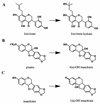Fungal resistance to plant antibiotics as a mechanism of pathogenesis
- PMID: 10477313
- PMCID: PMC103751
- DOI: 10.1128/MMBR.63.3.708-724.1999
Fungal resistance to plant antibiotics as a mechanism of pathogenesis
Abstract
Many plants produce low-molecular-weight compounds which inhibit the growth of phytopathogenic fungi in vitro. These compounds may be preformed inhibitors that are present constitutively in healthy plants (also known as phytoanticipins), or they may be synthesized in response to pathogen attack (phytoalexins). Successful pathogens must be able to circumvent or overcome these antifungal defenses, and this review focuses on the significance of fungal resistance to plant antibiotics as a mechanism of pathogenesis. There is increasing evidence that resistance of fungal pathogens to plant antibiotics can be important for pathogenicity, at least for some fungus-plant interactions. This evidence has emerged largely from studies of fungal degradative enzymes and also from experiments in which plants with altered levels of antifungal secondary metabolites were generated. Whereas the emphasis to date has been on degradative mechanisms of resistance of phytopathogenic fungi to antifungal secondary metabolites, in the future we are likely to see a rapid expansion in our knowledge of alternative mechanisms of resistance. These may include membrane efflux systems of the kind associated with multidrug resistance and innate resistance due to insensitivity of the target site. The manipulation of plant biosynthetic pathways to give altered antibiotic profiles will also be valuable in telling us more about the significance of antifungal secondary metabolites for plant defense and clearly has great potential for enhancing disease resistance for commercial purposes.
Figures











Similar articles
-
The arms race continues: battle strategies between plants and fungal pathogens.Curr Opin Microbiol. 2005 Aug;8(4):399-404. doi: 10.1016/j.mib.2005.06.008. Curr Opin Microbiol. 2005. PMID: 15996507 Review.
-
Antimicrobial phytoprotectants and fungal pathogens: a commentary.Fungal Genet Biol. 1999 Apr;26(3):163-8. doi: 10.1006/fgbi.1999.1133. Fungal Genet Biol. 1999. PMID: 10361030 Review.
-
Phytoalexins from the Vitaceae: biosynthesis, phytoalexin gene expression in transgenic plants, antifungal activity, and metabolism.J Agric Food Chem. 2002 May 8;50(10):2731-41. doi: 10.1021/jf011429s. J Agric Food Chem. 2002. PMID: 11982391 Review.
-
The chemical ecology of crucifers and their fungal pathogens: boosting plant defenses and inhibiting pathogen invasion.Chem Rec. 2008;8(2):109-15. doi: 10.1002/tcr.20140. Chem Rec. 2008. PMID: 18383155 Review.
-
Metabolism and detoxification of phytoalexins and analogs by phytopathogenic fungi.Phytochemistry. 2005 Feb;66(4):391-411. doi: 10.1016/j.phytochem.2004.12.032. Phytochemistry. 2005. PMID: 15694450 Review.
Cited by
-
Identification and localization of bioactive naphthoquinones in the roots and rhizosphere of Paterson's curse (Echium plantagineum), a noxious invader.J Exp Bot. 2016 Jun;67(12):3777-88. doi: 10.1093/jxb/erw182. Epub 2016 May 18. J Exp Bot. 2016. PMID: 27194735 Free PMC article.
-
Plant antimicrobial agents and their effects on plant and human pathogens.Int J Mol Sci. 2009 Jul 31;10(8):3400-3419. doi: 10.3390/ijms10083400. Int J Mol Sci. 2009. PMID: 20111686 Free PMC article. Review.
-
Metabolism and resistance of Fusarium spp. to the manzamine alkaloids via a putative retro pictet-spengler reaction and utility of the rational design of antimalarial and antifungal agents.Mar Biotechnol (NY). 2014 Aug;16(4):412-22. doi: 10.1007/s10126-014-9557-0. Epub 2014 Feb 20. Mar Biotechnol (NY). 2014. PMID: 24553735 Free PMC article.
-
Review of herbal medicine works in the avian species.Vet World. 2021 Nov;14(11):2889-2906. doi: 10.14202/vetworld.2021.2889-2906. Epub 2021 Nov 11. Vet World. 2021. PMID: 35017836 Free PMC article. Review.
-
The Aspergillus nidulans Zn(II)2Cys6 transcription factor AN5673/RhaR mediates L-rhamnose utilization and the production of α-L-rhamnosidases.Microb Cell Fact. 2014 Nov 22;13:161. doi: 10.1186/s12934-014-0161-9. Microb Cell Fact. 2014. PMID: 25416526 Free PMC article.
References
-
- Adrian M, Jeandet P, Veneau J, Weston L A, Bessis R. Biological activity of resveratrol, a stilbenic compound from grapevines, against Botrytis cinerea, the causal agent for gray mould. J Chem Ecol. 1997;23:1689–1702.
-
- Adrian M, Rajaei H, Jeandet P, Veneau J, Bessis R. Resveratrol oxidation in Botrytis cinerea conidia. Phytopathology. 1998;88:472–476. - PubMed
-
- Ardi R, Kobiler I, Jacoby B, Keen N T, Prusky D. Involvement of epicatechin biosynthesis in the activation of the mechanism of resistance of avocado fruits to Colletotrichum gloeosporioides. Physiol Mol Plant Pathol. 1998;53:269–285.
-
- Argandoña V H, Corcuera L J. Distribution of hydroxamic acids in Zea mays tissues. Phytochemistry. 1985;24:177–178.
-
- Argandoña V H, Zúniga G E, Corcuera L J. Distribution of gramine and hydroxamic acids in barley and wheat leaves. Phytochemistry. 1987;26:1917–1918.
Publication types
MeSH terms
Substances
LinkOut - more resources
Full Text Sources
Other Literature Sources
Medical

